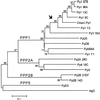Identification of five new genes on the Y chromosome of Drosophila melanogaster
- PMID: 11687639
- PMCID: PMC60852
- DOI: 10.1073/pnas.231484998
Identification of five new genes on the Y chromosome of Drosophila melanogaster
Abstract
The heterochromatic state of the Drosophila Y chromosome has made the cloning and identification of Y-linked genes a challenging process. Here, we report application of a procedure to identify Y-linked gene fragments from the unmapped residue of the whole genome sequencing effort. Previously identified Y-linked genes appear in sequenced scaffolds as individual exons, apparently because many introns have become heterochromatic, growing to enormous size and becoming virtually unclonable. A TBLASTN search using all known proteins as query sequences, tested against a blastable database of the unmapped fragments, produced a number of matches consistent with this scenario. Reverse transcription-PCR and genetic methods were used to confirm those that are expressed, Y-linked genes. The five genes reported here include three protein phosphatases (Pp1-Y1, Pp1-Y2, and PPr-Y), an occludin-related gene (ORY), and a coiled-coils gene (CCY). This brings the total to nine protein-coding genes identified on the Drosophila Y chromosome. ORY and CCY may correspond, respectively, to the fertility factors ks-1 and ks-2, whereas the three protein phosphatases represent novel genes. There remains a strong functional coherence to male function among the genes on the Drosophila Y chromosome.
Figures




References
-
- Morgan T H. Science. 1910;32:120–122. - PubMed
Publication types
MeSH terms
Substances
Associated data
- Actions
- Actions
- Actions
- Actions
- Actions
- Actions
LinkOut - more resources
Full Text Sources
Molecular Biology Databases
Research Materials

